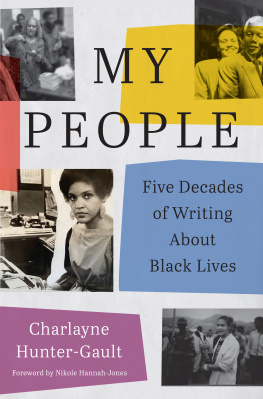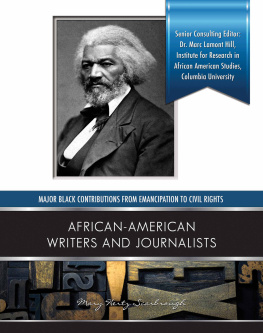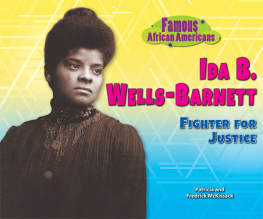RAISING HER VOICE
RAISING HER VOICE
African-American Women Journalists Who Changed History
Rodger Streitmatter
Copyright 1994 by The University Press of Kentucky
Scholarly publisher for the Commonwealth, serving Bellarmine University, Berea College, Centre College of Kentucky, Eastern Kentucky University, The Filson Historical Society, Georgetown College, Kentucky Historical Society, Kentucky State University, Morehead State University, Murray State University, Northern Kentucky University, Transylvania University, University of Kentucky, University of Louisville, and Western Kentucky University.
All rights reserved.
Editorial and Sales Offices: The University Press of Kentucky
663 South Limestone Street, Lexington, Kentucky 40508-4008
www.kentuckypress.com
PHOTO CREDITS: Maria W. Stewart (woodcut, which appeared with Stewarts essays in the Liberator, reprinted by permission of the Houghton Library, Harvard University). Mary Ann Shadd Cary (reprinted from Elizabeth Lindsay Davis, Lifting as They Climb [Washington: National Association of Colored Women, 1933]). Gertrude Bustill Mossell and Josephine St. Pierre Ruffin (reprinted from G.F. Richings, Evidences of Progress among Colored People [Philadelphia: George S. Ferguson, 1897]). Ida B. Wells-Barnett (reprinted, by permission, from Wells-Barnetts Crusade for Justice: The Autobiography of Ida B. Wells, edited by Alfreda M. Duster 1970 by The University of Chicago Press). Delilah L. Beasley (reprinted from Beasleys The Negro Trail Blazers of California [Los Angeles: 1919]). Marvel Cooke (courtesy of Cooke). Charlotta A. Bass (by permission of the Southern California Library for Social Studies and Research). Alice Allison Dunnigan (courtesy of Robert Dunnigan). Ethel L. Payne (courtesy of Payne). Charlayne Hunter-Gault (courtesy of MacNeil/Lehrer Productions/Bruce Lawrence).
Library of Congress Cataloging-in-Publication Data
Streitmatter, Rodger.
Raising her voice : African-American women journalists who changed history / Rodger Streitmatter.
p. cm.
Includes bibliographical references (p. ) and index.
ISBN 0-8131-1861-1; 0-8131-0830-6 (acid-free)
1. Afro-American journalistsBiography. 2. Afro-American womenBiography. 3. JournalismUnited StatesHistory19th century. 4. JournalismUnited StatesHistory20th century. I. Title.
PN4872.S66 1994
[B]
ISBN-13: 978-0-8131-0830-8
This book is printed on acid-free recycled paper meeting the requirements of the American National Standard for Permanence in Paper for Printed Library Materials.
Manufactured in the United States of America.
| Member of the Association of
American University Presses |
CONTENTS
Acknowledgments
Introduction
1. MARIA W. STEWART
Firebrand of the Abolition Movement
2. MARY ANN SHADD CARY
Advocate for Canadian Emigration
3. GERTRUDE BUSTILL MOSSELL
Guiding Voice for Newly Freed Blacks
4. IDA B. WELLS-BARNETT
Militant Crusader Against Lynching
5. JOSEPHINE ST. PIERRE RUFFIN
Driving Force in the Womens Club Movement
6. DELILAH L. BEASLEY
Voice for Accommodation and Conciliation
7. MARVEL COOKE
Literary Journalist of the Harlem Renaissance
8. CHARLOTTA A. BASS
Radical Precursor of the Black Power Movement
9. ALICE ALLISON DUNNIGAN
Champion of the Decline of Jim Crow
10. ETHEL L. PAYNE
Agent for Change in the Civil Rights Movement
11. CHARLAYNE HUNTER-GAULT
Creator of a Human Face behind the Contemporary Black Struggle
A Synthesis
Notes
Index
I dedicate this book to TOM GROOMS.
On so many occasions and in so many
ways, he cleared my mind.
ACKNOWLEDGMENTS
When I submitted my first manuscript to a scholarly journal, my research skills were at such an elementary level that any editor in her right mind would have summarily rejected the manuscript. Fortunately, Susan Henry, then editor of Journalism History, assiduously avoids being of the right mind. I have benefited immensely from Susans daunting intellectual timber as well as her personal commitment to making the world better. Without her, neither that first manuscript nor this book would ever have been published. I thank her.
My second scholarly mentor has been Maurine Beasley. Maurines integrity, dedication, support, and energy provide a model to which I continue to aspire.
Much of the material in this book originated as conference papers and articles in scholarly journals. Among those persons whose contributions I want to acknowledge, therefore, are dozens of individuals I cannot name because their identities are masked behind the blind review process of the American Journalism Historians Association, History Division of the Association for Education in Journalism and Mass Communication, Institute for Massachusetts Studies, Journalism Quarterly, Journalism History, Howard Journal of Communications, and Afro-Americans in New York Life and History. Fortunately, the reviewers know who they are, just as I know how much I have gained from them.
In addition, I am indebted to Bernell Tripp for generously sharing her research on African-American journalists with me and to Jerry Baldasty and Barbara Cloud for their friendship, their standard of excellence, and their willingness to critique my work.
On my own faculty in The American Universitys School for Communication, I thank my colleagues Barbara Diggs-Brown for working with me on the Marvel Cooke chapter and Sanford J. Ungar and Laird Anderson for providing unwavering support and encouragement.
I very much appreciate the financial support that Dean Ungar and Betty Bennett, dean of the College of Arts and Sciences, have provided for my research. The District of Columbia Community Humanities Council also has supported my work through two grants that produced public exhibits about Alice Dunnigan and Ethel Payne.
Fern S. Ingersoll of the Women in Journalism Oral History Project of the Washington Press Club Foundation has been an invaluable resource and friend, both through the rich materials she has produced for scholars and the professional standards she has exemplified.
Marvel Cooke, Charlayne Hunter-Gault, and the late Ethel Payne graciously granted me the time to interview them in order to bring more depth to the manuscript. Robert Dunnigan allowed me to rummage through his garage for photographs and other material about his mother.
Much of the information contained in this book could not have been unearthed without the assistance of the individuals working in a long list of research insititutions around the country, from the Moorland-Spingarn Research Center at Howard University to the Rare Books and Manuscripts Division at the Chicago Historical Society. Above all others, I thank Sarah Cooper of the Southern California Library for Social Studies and Research for going far more than the extra mile to help illuminate the life and work of Charlotta Bass.










